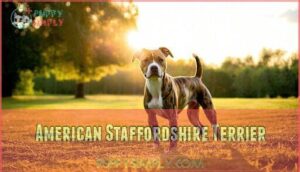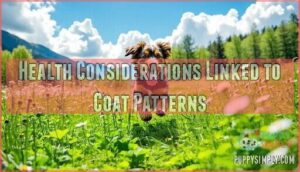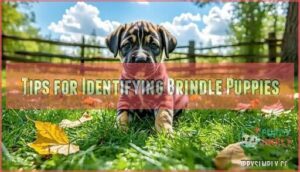This site is supported by our readers. We may earn a commission, at no cost to you, if you purchase through links.

This genetic pattern appears in over 30 breeds, from popular Boxers and Great Danes to unique breeds like Plott Hounds and Irish Wolfhounds.
The K locus controls this distinctive striping through specific alleles, creating variations from subtle shadow stripes to bold contrasting bands.
Some breeds display reverse brindle, where light stripes appear on dark backgrounds.
Brindle doesn’t affect health but creates beautiful coat diversity across breeds of all sizes, and each breed expresses their own interpretation of this natural striping pattern.
Table Of Contents
- Key Takeaways
- What is a Brindle Dog Breed?
- How Does The Brindle Pattern Occur?
- Most Popular Brindle Dog Breeds
- Unique and Rare Brindle Breeds
- Brindle Coat Traits and Care Tips
- Frequently Asked Questions (FAQs)
- What dog breeds have a brindle?
- What color is a brindle dog?
- Do dogs have a brindle coat?
- Is Brindle a greyhound?
- What dog breeds have cream brindle coats?
- What is a brindle tiger striped dog?
- Are there any specific grooming requirements for dogs with brindle coats?
- Can brindle patterns change as dogs age?
- Are brindle dogs more expensive than solid-colored ones?
- Do brindle dogs have different temperaments than others?
- Conclusion
Key Takeaways
- You’ll find brindle patterns in over 30 dog breeds, from popular choices like Boxers and Great Danes to rare breeds like Plott Hounds and Irish Wolfhounds, giving you plenty of options regardless of size preference.
- The K locus controls brindle genetics, creating variations from subtle shadow stripes to bold contrasting bands, with some breeds displaying reverse brindle where light stripes appear on dark backgrounds.
- Brindle coats don’t require special grooming or affect your dog’s health, making maintenance as simple as regular brushing and standard care routines without worrying about pattern-related issues.
- You can identify brindle puppies early through visual stripe patterns, though some faint markings intensify with age, and DNA testing can confirm the brindle genotype before full coat development.
What is a Brindle Dog Breed?
You’ve probably spotted dogs with tiger-like stripes and wondered what creates those stunning coat patterns.
Brindle is a genetic coat pattern that produces dark stripes over a lighter base color, creating a distinctive striped appearance that varies from subtle to bold across different breeds.
Nature’s tiger stripes in your living room—brindle coats blend wild beauty with loyal companionship
Definition of Brindle Coat Pattern
Brindle coat patterns create a distinctive tiger-like appearance through dark stripes overlaying lighter base colors.
This genetic trait produces varying stripe intensities and distributions across different brindle dog breeds, making each dog’s pattern unique.
Key characteristics of brindle patterns include:
- Dark brown or black stripes over red, fawn, or brown base colors
- Stripe patterns ranging from subtle to bold contrast levels
- Reverse brindle featuring light stripes on dark backgrounds
- Coat variations appearing throughout the body or in specific areas
- Color genetics controlled by the K locus brindle allele
Some variations can even include rare blue nose colors, which is a result of the unique genetic trait and color genetics.
Common Colors and Markings
You’ll see brindle dog breeds sporting stunning base coat shades like red, fawn, brown, and silver.
The dark stripes create beautiful contrast against these lighter backgrounds.
Pattern distribution varies widely – some dogs show full-body coverage while others display localized brindling.
Stripe width variation adds character, with some pups having fine lines and others bold bands.
Masked brindle appears muted in certain lighting conditions, and the overall effect can be quite striking with beautiful contrast.
Reverse Brindle and Variations
While traditional brindle features dark stripes on light backgrounds, reverse brindle flips this pattern.
You’ll spot light stripes dancing across darker coats in these striking variations.
Fawn brindle showcases subtle tan striping, while dilute brindle presents muted tones.
Merle brindle creates complex patterns when genetics collide.
Brindle masking can hide striping entirely, and atypical striping breaks conventional rules in fascinating ways.
How Does The Brindle Pattern Occur?
You might wonder why your brindle dog’s stripes look so unique compared to others of the same breed.
The brindle pattern occurs through specific genetic mutations at the K locus, where the brindle allele creates a mosaic effect of dark eumelanin stripes over a lighter pheomelanin base coat.
Nature’s genetic artistry creates stunning tiger-stripe patterns through complex K locus mutations in brindle dogs
Genetic Basis of Brindle Coats
Behind every brindle dog’s stunning coat lies complex dog genetics at work.
The K locus controls this pattern through specific brindle alleles that interact with masking genes to create those signature stripes.
Here’s how brindle genetics work:
- K Locus Control: The kbr allele produces brindle patterns when present
- Agouti Interaction: Base coat colors come from agouti gene combinations
- Masking Genes: Dominant black (KB) can hide brindle completely
- Reverse Brindle: Extra eumelanin creates light stripes on dark backgrounds
Understanding these genetic traits helps explain why brindle dog breeds show such varied stripe patterns and intensities.
Factors Affecting Brindle Expression
Several factors can mask or modify how brindle patterns appear in your dog.
Gene masking occurs when dominant black alleles hide brindle traits completely.
Modifier genes affect stripe intensity and distribution across different body regions.
Age effects may reveal brindle markings as puppies mature.
Environmental factors like nutrition barely influence pattern development, while health impacts remain minimal in most brindle dog breeds.
Understanding the genetics of brindle coat patterns is essential for breeders to predict and enhance the desired traits in their dogs.
Species Beyond Dogs With Brindle Patterns
You’ll find brindle patterns across many species beyond brindle pattern dogs.
Cattle brindle appears in livestock breeds, while horse coats display similar striping.
Guinea pig genetics produce brindle markings, and cat genetics create tabby-like patterns.
Even lizard patterns show brindle-type coloration.
This shared genetic mechanism demonstrates how nature repeats successful camouflage and visual strategies across different animal families.
Most Popular Brindle Dog Breeds
You’ll find brindle patterns in some of today’s most beloved dog breeds, from gentle giants to compact companions.
These popular breeds showcase the brindle gene’s beautiful striping in various intensities and color combinations.
Boxer
Among brindle dog breeds, Boxers showcase stunning tiger-stripe patterns that make them instantly recognizable.
You’ll find brindle in roughly 30% of Boxers, featuring dark stripes over golden-fawn bases.
Their striped coats require standard Boxer grooming techniques, while Boxer exercise needs remain consistent regardless of coloration.
These brindle colored dogs maintain typical Boxer behavior and training requirements.
For Boxer owners, understanding the dog breed standards is essential for their pet’s overall well-being.
Great Dane
Great Dane brindle patterns feature striking black stripes over yellow-gold bases, creating chevron designs prized in show rings.
These Gentle Giants display less than 15% brindle occurrence among registered dogs.
Despite their Giant Companions status and Large Breed classification, brindle Great Danes require no special grooming.
Dane Training remains consistent regardless of coat color patterns.
For new owners, understanding Great Dane puppies is essential for proper care and development of their Great Dane.
French Bulldog
French Bulldogs showcase brindle as their most common coat pattern, appearing in over 40% of these compact companions.
Their French Origin traces back to 1800s lace workers who bred English Bulldogs with local ratters.
The Bulldog Size makes them perfect apartment dwellers, while their Breed History reveals selective breeding for the distinctive "bat ears."
Pet Care remains straightforward with minimal grooming needs. Training Tips focus on positive reinforcement since these brindle canine breeds can be stubborn yet keen to please.
For ideal care, understanding French Bulldog products is essential.
Boston Terrier
Boston Terrier History traces back to 1800s Massachusetts, where these compact companions earned their "American Gentleman" nickname.
Today’s Breed Standards recognize brindle as one of three official coat colors. These striped dog breeds showcase distinctive tuxedo markings alongside their tiger-like patterns.
- Brindle characteristics: Dark stripes over lighter base create stunning contrast with white markings
- Terrier Training: Intelligent nature makes them responsive to positive reinforcement methods
- Pet Grooming: Low-maintenance coats require weekly brushing to maintain brindle pattern visibility
American Staffordshire Terrier
Power defines the American Staffordshire Terrier’s brindle presence.
You’ll find brindle constitutes a significant portion of registered AmStaffs, especially in show circuits.
These dogs display various shades from light golden-tan with brown stripes to dark stripes over rich red hues, meeting breed standards perfectly.
| Brindle Characteristic | Pattern Description | Show Recognition |
|---|---|---|
| Light Base Stripes | Golden-tan with brown bands | AKC accepted coloration |
| Medium Intensity | Balanced stripe contrast | Frequently wins shows |
| Dark Rich Hues | Deep red with black stripes | Desirable breed standard |
Studies confirm no difference in behavior or lifespan between brindle and non-brindle AmStaffs.
The brindle coat’s appearance can change with sunlight and seasonal shedding, affecting pattern visibility.
These striped canine breeds require consistent terrier training and proper exercise needs to channel their energy effectively.
Plott Hound
Born from the rugged mountains of North Carolina, you’ll find the Plott Hound stands as America’s only native coonhound breed.
These brindle striped dogs showcase remarkable hunting ability and unwavering loyalty that’ll steal your heart.
What Makes Plott Hounds Special:
- Legendary Plott Hound History – German immigrants brought their boarhounds to Carolina in 1750, creating this unique lineage
- Unmatched Hunting Ability – They’ll track bears and wild boar with fearless determination across treacherous terrain
- Distinctive Brindle Patterns – Their coats display stunning tiger-like stripes that set them apart from Treeing Tennessee Brindle cousins
- Loyal Family Companions – Despite their hunting prowess, they’re gentle giants who bond deeply with their families
Unique and Rare Brindle Breeds
While you might recognize some popular brindle breeds, several uncommon varieties showcase this striking pattern in unexpected ways.
These rare brindle dogs often come from ancient bloodlines or specialized working backgrounds, making them fascinating examples of genetic diversity within the canine world.
Irish Wolfhound
You’ll find the Irish Wolfhound’s ancient origins trace back to 500 B.C., where this gentle giant earned its place in Irish history.
Standing over 30 inches tall, wolfhound size makes these dogs impressive companions.
Brindle variations appear in fewer than 5% of registered Irish Wolfhounds worldwide, making this canine coat pattern exceptionally rare among brindle dog breeds.
Their wolfhound temperament remains consistently gentle despite breed standards favoring solid colors in shows.
Cardigan Welsh Corgi
Unlike their towering wolfhound cousins, Cardigan Welsh Corgis pack their brindle beauty into a compact frame.
These Welsh legends showcase unique canine coat patterns that distinguish them from Pembroke Corgis. Their brindle breed characteristics create stunning striped displays across their sturdy bodies.
Cardigan Welsh Corgi Brindle Facts:
- Corgi History: Ancient Welsh Origins dating back to 1000 B.C. make them one of the oldest brindle dog breeds
- Corgi Size: Low-riding at 10.5-12.5 inches, perfect for apartment living despite their herding heritage
- Corgi Temperament: Loyal, intelligent companions with strong herding instincts and protective nature
- Corgi Training: Responds well to positive reinforcement, though their independent streak requires consistent guidance
Akita
Akita brindle patterns showcase the breed’s majestic presence with distinctive "tiger-striped" coats.
These brindle dog breeds display three primary brindle variations: black, red, and silver stripes.
Japanese Akita lines commonly feature this canine coat pattern, appearing in under 15% of the population.
Akita Training requires consistency due to their independent nature.
Akita Grooming needs increase during seasonal coat changes when brindle breed characteristics become more pronounced.
Whippet
Whippets showcase brindle patterns in roughly 20% of the breed, displaying tiger-like stripes across fawn, blue, or red base coats.
These gentle sighthounds need minimal Whippet Grooming but require consistent Whippet Exercise and positive Whippet Training.
Their sensitive Whippet Behavior responds well to gentle handling, while proper Whippet Nutrition supports their lean athletic build in these striking brindle dog breeds.
Understanding the whippet breed overview is essential for providing the right care and environment for this unique breed.
Mountain Cur
You’ll find Mountain Cur among the most versatile brindle dog breeds, with their Mountain Origins deeply rooted in Appalachian hunting traditions.
Their Breed History traces back centuries, where selective breeding created these exceptional working dogs with distinctive brindle markings.
This breed’s Cur Temperament combines fierce loyalty with remarkable intelligence, making Training Tips essential for channeling their natural Hunting Ability.
Bull Terrier
Throughout Bull Terrier History, these distinctive dogs rarely display brindle patterns in modern bloodlines.
Your brindle dog breeds research might disappoint you—Bull Terriers typically showcase white, black, or colored coats instead.
While Breed Standards technically allow brindle markings, they’re exceptionally uncommon today.
Bull Behavior remains consistent regardless of coat color, though Terrier Training benefits from their natural intelligence.
Striped dog patterns in Bull Terriers represent genetic rarities worth celebrating.
Cairn Terrier
Cairn Terriers showcase brindle patterns in roughly 15% of the breed population.
These Scottish working dogs display subtle tiger-striped coats that enhance their rugged appearance while maintaining their spirited personality.
- Cairn Grooming: Weekly brushing prevents matting in their double coat
- Terrier Training: Early socialization curbs their natural hunting instincts
- Dog Nutrition: High-protein diets support their active metabolism
- Cairn Exercise: Daily walks satisfy their moderate energy needs
- Terrier Health: Regular vet checkups monitor breed-specific conditions
Brindle Coat Traits and Care Tips
You’ll notice that your brindle dog’s coat pattern can change dramatically as they age, with stripes becoming more or less defined over time.
Understanding these unique coat traits helps you provide the best care and know what to expect from your striped companion.
Variation in Stripe Intensity and Coverage
You’ll notice brindle dog breeds showcase incredible stripe patterns with varying intensity levels and coverage areas.
Some dogs sport bold, tiger-striped patterns across their entire coat, while others display subtle striping in specific areas.
Color variance ranges from deep chocolate stripes on fawn bases to light cream markings on dark coats.
Texture influence affects visibility—shorter coats reveal crisp brindle dog characteristics more clearly than longer fur.
Grooming Needs for Brindle Dogs
Brindle dog grooming doesn’t require special techniques, but understanding your dog’s coat helps optimize care.
Regular brushing prevents matting and controls shedding, while proper maintenance keeps those beautiful stripes looking sharp.
Essential grooming tasks include:
- Coat Maintenance: Brush weekly to distribute natural oils and remove loose fur
- Shedding Control: Use de-shedding tools during seasonal coat changes
- Nail Care: Trim every 2-3 weeks to prevent overgrowth and splitting
- Ear Cleaning: Check weekly for debris, especially in floppy-eared brindle breeds
Your dog’s skin health affects stripe visibility and overall appearance.
Health Considerations Linked to Coat Patterns
Good news for dog lovers: brindle dog breeds don’t carry special health risks tied to their stunning coat color pattern.
Unlike merle genetics, the brindle genetic trait doesn’t cause eye problems or genetic disorders.
Your striped pup won’t face increased skin issues or allergic reactions simply because of their beautiful markings.
Coat diseases aren’t linked to dog coat genetics either.
Understanding the brindle pitbull genetics is essential for responsible dog ownership and care.
Tips for Identifying Brindle Puppies
Spotting future striped companions starts early when you know what to look for. Brindle markings appear as tiger-like stripes from birth, though some puppies show faint patterns that intensify with age. DNA testing confirms brindle genotype before full coat development.
Here are key identification tips:
- Visual Pattern Recognition: Look for alternating dark and light streaks on legs, face, and sides – classic brindle dog breeds show distinct striping even in newborns.
- Genetic Testing: K locus DNA tests reveal brindle carriers before stripe visibility develops, especially helpful in breeds with variable coat patterns.
- Parental History Review: Check breeder records for brindle ancestry – striped dog patterns often skip generations but reappear in offspring unexpectedly.
Frequently Asked Questions (FAQs)
What dog breeds have a brindle?
Like tiger stripes painting a canvas, brindle coats create stunning patterns through genetic artistry.
You’ll find brindle in Boxers, Great Danes, Mastiffs, Boston Terriers, French Bulldogs, Whippets, and many other breeds displaying this distinctive striped coloration.
What color is a brindle dog?
You’ll see brindle dogs sporting a tiger-like coat pattern with dark stripes over lighter base colors like red, fawn, brown, or tan backgrounds.
Do dogs have a brindle coat?
Consider the English Mastiff’s massive frame carrying tiger-like stripes – that’s nature’s brindle artistry at work.
Yes, dogs absolutely have brindle coats.
This genetic pattern creates dark stripes over lighter base colors, appearing in breeds like Boxers, Great Danes, and French Bulldogs.
Is Brindle a greyhound?
No, brindle isn’t a greyhound – it’s a coat pattern. Greyhounds can have brindle coats, but many other breeds also display this tiger-stripe coloring, including boxers, mastiffs, and bulldogs.
What dog breeds have cream brindle coats?
Countless breeds can rock cream brindle coats! You’ll find this stunning pattern in Boxers, Great Danes, French Bulldogs, Whippets, Boston Terriers, and Mastiffs when cream genes interact with brindle genetics.
What is a brindle tiger striped dog?
A tiger-striped dog features dark stripes over a lighter base coat, resembling tiger markings.
You’ll find this brindle pattern in breeds like Boxers, Great Danes, and Whippets, where genetic variations create distinctive striped appearances.
Are there any specific grooming requirements for dogs with brindle coats?
You don’t need special grooming for brindle coats. Regular brushing removes loose hair and keeps stripes looking sharp. Focus on basic care: weekly brushing, occasional baths, and nail trims.
Can brindle patterns change as dogs age?
Yes, brindle patterns can shift as dogs mature.
Puppies born with solid coats may develop stripes later, while existing patterns can become more or less pronounced with age due to changing hair texture and color intensity.
Are brindle dogs more expensive than solid-colored ones?
Like a rare gem in a jewelry store, pricing depends on breed and breeder.
Standard brindle colors typically cost less than rare variations. Most brindle patterns don’t command premium pricing over solid colors unless combined with uncommon traits.
The cost of a Black Brindle French Bulldog can be influenced by factors related to breed characteristics, which is a key aspect to consider when determining the value of such a dog, with breed being a crucial factor.
Do brindle dogs have different temperaments than others?
Coat color doesn’t determine personality. Brindle dogs share the same temperamental traits as their solid-colored littermates since genetics control pattern and temperament separately through different mechanisms.
Conclusion
Whether you’re drawn to the bold stripes of a Boxer or the subtle patterns of an Irish Wolfhound, brindle dog breeds offer remarkable genetic artistry.
These distinctive coats result from specific K locus alleles creating unique striping patterns. Each breed expresses brindle differently, from reverse patterns to shadow stripes.
Understanding the genetics helps you appreciate these natural variations. Proper grooming maintains their striking appearance while health considerations remain minimal.
Brindle patterns don’t affect temperament, making these visually stunning dogs excellent companions for families seeking both beauty and personality in their four-legged friends.
- https://www.petsradar.com/advice/brindle-dog-breeds
- https://onlinelibrary.wiley.com/doi/10.1111/age.13154
- https://www.akc.org/dog-breeds/treeing-tennessee-brindle/
- https://sitmeanssit.com/dog-training-mu/swlv-dog-training/the-best-brindle-dog-breeds/
- https://wildearth.com/blogs/dog-knowledge/brindle-pitbull-breed-guide


















